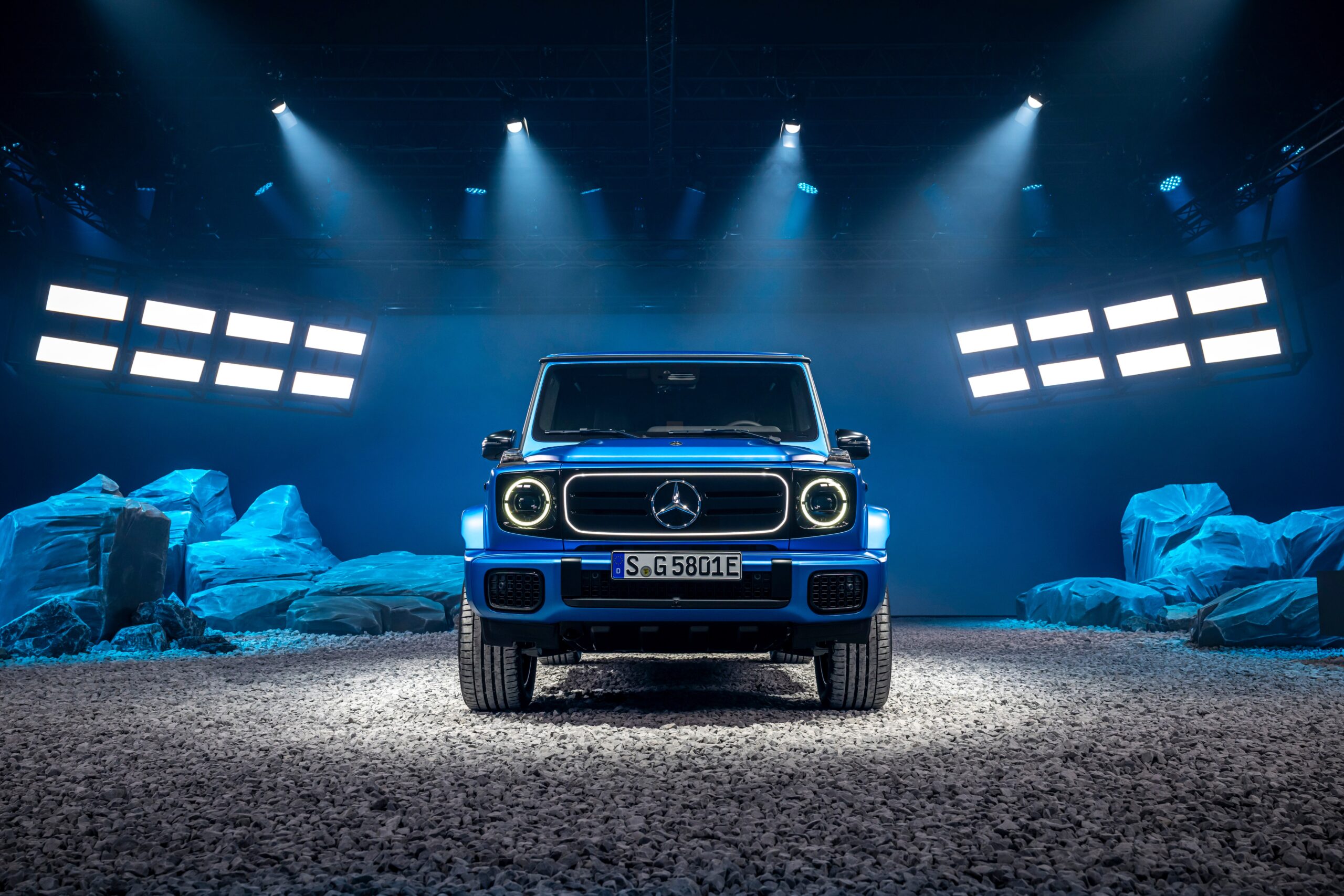It may well be able to wade through deep water, have crawl-assist mode for sketchy terrain, and even perform 360-degree swivel-on-the-spot tank turns, but sales of the seemingly much-anticipated electric Mercedes G-Class SUV have been poor. Actually, that’s an understatement. They’ve been woeful.
And it’s not the only e-flop from a legacy automaker: Just last week Ferrari announced that it is delaying its second EV model (the first will arrive in October) until at least 2028 because of weak demand. Porsche has cut back its plans for EVs amid soft sales of its electric Macan SUV and Taycan models. Indeed, depreciation on the Taycan is so eye-watering that some Porsche dealers have supposedly refused to take their own brand’s performance EV from owners looking to offload or upgrade.
And after the February closure of its Belgian factory, Audi’s Q8 E-tron has been discontinued. The shuttering of the Brussels plant, says Audi, was due to a “global decline in customer orders in the electric luxury class segment.” Yet, at the same time, global sales of EVs are going gangbusters—so what gives?
Audi’s Q8 E-tron has been discontinued following a “global decline in customer orders in the electric luxury class segment.”
Photograph: AUDI AG
“The transition to EVs is not just a case of putting a battery in a vehicle,” says Peter Wells, a business professor and director of the Center for Automotive Industry Research at Cardiff University in Wales, UK. “Large premium EVs require very large batteries to match anything like the performance of typical ICE versions, and this increases their price.”
Indeed, the all-electric G-Wagen will set you back a staggering $162,000. The full EV Range Rover coming later this year is expected to cost even more, supposedly retailing for upwards of $180,000. “For years, brands like Porsche, Audi, and others have been able to expand output and model ranges while continuing to command premium prices in the market. Those days are now over,” says Wells.
Mercedes sold just 1,450 G-Class G580 off-roaders in Europe through to April of this year, German newspaper Handelsblatt recently revealed, noting that this was considerably below the cheaper combustion variants, which totaled 9,700 sales. The G-Class—formerly the G-Wagen, or Geländewagen, German for “cross-country vehicle” and originally developed for the German army—is a 45-year-old design, massively updated in 2022, but still ruggedly boxy when most EVs are aero and svelte. However, thanks to potential tariffs of up to 50 percent on imported cars from Europe, Mercedes likely won’t be able to rely on the US to make up for its poor European sales for the electrified G-Wagen.
Handelsblatt cited an unnamed company insider saying the G580 has been a “complete flop” since its launch in April last year. This is not the official line. “Mercedes-Benz is prepared for all market scenarios,” says an email from company PR officer Markus Nast. “Into the 2030s, we can flexibly offer vehicles with both a fully electric drivetrain or an electrified high-tech combustion engine. Our customers decide what suits them best.”
But it seems those customers are mostly choosing cheaper ICE versions rather than the e-makeovers. Why settle for the faux G-Roar—a soundbar-actuated facsimile of a V8 engine piped into and around the electric G-Wagen—when you can have the genuine grumble, and at less cost? The extra $14,000 is an awful lot to pay for an all-terrain EV that on the outside appears almost the same as the $148,000 gas variant.
The ICE version of the G-Wagen might not have a button-activated 720-degree on-the-spot spin—a road-chewing donuting feature first introduced by Rivian yet soon dropped—but the gas guzzler has a 500-mile range while the G580 can only manage 239 miles, a likely deal breaker for those who want to travel long distances for their off-asphalt adventures (even though electric powertrains have much to offer 4×4 action, with instant torque, better traction, less maintenance and a lower center of gravity.)
Porsche has cut back its plans for EVs amid soft sales of the electric Macan SUV and Taycan.
Photograph: Porsche
Of course, this is likely not a whole heap of customers. Most G-Wagens—ICE and electric—live in the city, owned as military-chic status symbols. Those truly into the niche world of long-range backcountry EVs can save $60,000 by shunning the 570-horsepower G580 with almost no towing capacity for a $105,000, 850-hp Rivian R1S with a 410-mile range and plenty of oomph left over for pulling stuff.
“Premium EVs [from legacy automakers] are not quite as amazing as they should be,” says Wells, and their introduction—in what could be characterized as the Cybertruck crunch—has often come at the cost of “neglecting the development of smaller EVs with mass appeal.”
On this front, legacy automakers are losing out to China, at least in those countries where Chinese EVs are sold. Which is most places except the US.
According to a new report from the Paris-based International Energy Agency (IEA), global EV sales will surpass 20 million in 2025, accounting for more than a quarter of cars sold worldwide. In the first three months of 2025, electric car sales worldwide were up 35 percent over the previous year. And, adds the IEA, market share is on course to exceed 40 percent by 2030 as EVs—smaller, cheaper ones, mainly—become increasingly affordable in more markets.
Almost half of all car sales in China last year were electric. Emerging markets in Asia and Latin America have also become new centers of growth, with total EV sales across these regions surging by more than 60 percent in 2024, according to the IEA. Meanwhile, EV sales grew by about 10 percent year-on-year in the US.
“Our data shows that, despite significant uncertainties, electric cars remain on a strong growth trajectory globally,” says IEA executive director Fatih Birol. “Sales continue to set new records, with major implications for the international auto industry. This year, we expect more than one in four cars sold worldwide to be electric, with growth accelerating in many emerging economies. By the end of this decade, it is set to be more than two in five.”
China, which accounts for more than 70 percent of global EV production, shipped nearly 1.25 million electric cars to other countries last year. The ending of EV subsidies in the EU has impacted European sales. According to the European Automobile Manufacturers’ Association, the EU’s EV market share in 2024 fell to 13.6 percent, down 1 percent from the prior year.
Volkswagen’s luxury marques, including Porsche, Bentley, and Lamborghini, are reassessing their EV strategies. Porsche has scaled back plans for an all-electric lineup following a 49 percent decline in Taycan sales. Bentley has pushed back the launch of its first EV from this year to next, and extended its gas-engine phase-out deadline to 2035. Lamborghini has delayed its Lanzador EV until 2029 at the earliest.
Wait a few months and you might well be able to pick up a G580 for considerably less than its $162,000 list price. You can currently bag a three-year-old Porsche Taycan, with its 416 miles of range, for less than half what it cost new. Currently, there are 930 used Taycans for sale in the US on Auto Trader, with prices ranging from just $44,000 when a base model costs at least $100,000 new. A Taycan with just 11,000 miles on the clock can be had for $47,000.
US and European car makers—legacy and startups—may wish there was high demand for premium-priced prestige EVs (Jaguar is staking its future business on this), but for some years now the market has been crying out, instead, for cheaper, entry-level models. The favored method by the modern auto industry of filling flagships with their best wares then letting these slowly trickle down to lower-tier cars is not realistic right now, says Dale Harrow, chair and director of the Intelligent Mobility Design Center at London’s Royal College of Art.
“The same tech is basically in all electric vehicles,” says Harrow. “So, for the first time, there’s no real guarantee that spending a lot more money is going to buy a better product. Look at the vehicles coming in from BYD.”
Instead, Harrow feels automakers must wean themselves off flagship-first dependancy, ape Ford’s classic Model T strategy, and concentrate on building EVs accessible to the masses through a combination of affordability, simplicity, and mass production. And guess who has already worked this out? Yep, China—where nearly 40 percent of all electric models are priced under $25,000.
It is this strategy, rather than gimmicky tank-turns, that will drive real adoption and encourage the spread of viable charging networks. After all, it was the ubiquity of the Model T that played a pivotal role in the development of gas stations—and there’s absolutely no reason why that same trick can’t be turned for the electric age.




